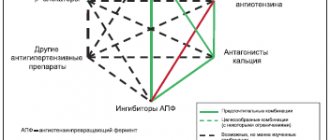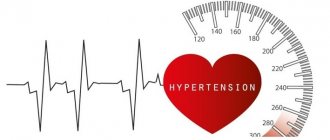Release form
Monopril is a white, round, biconvex, odorless tablet, scored on one edge and engraved “609” or “158” on the other.
Available according to:
- 14 such tablets of 20 mg in a blister, two blisters in a paper pack;
- 10 such tablets of 10 mg each in a blister made of plastic and aluminum foil, one or two blisters in a paper pack;
- 14 such tablets of 10 mg each in a blister made of plastic and aluminum foil, one or two blisters in a paper pack.
Directions for use and doses
Inside. The dosage of the drug should be selected individually.
Arterial hypertension. The recommended starting dose of the drug is 10 mg once a day. The dose must be selected depending on the dynamics of blood pressure reduction.
The usual dose is 10 to 40 mg once daily. In the absence of a sufficient hypotensive effect, additional diuretics may be prescribed.
If treatment with Monopril® is started against the background of diuretic therapy, then its initial dose should be no more than 10 mg with careful medical monitoring of the patient’s condition.
Heart failure. The recommended starting dose is 5 mg 1 or 2 times a day. Depending on the therapeutic effectiveness, the dose can be increased at weekly intervals up to a maximum of 40 mg once a day.
Arterial hypertension and heart failure with impaired renal or liver function
Since the drug is eliminated from the body in two ways, dose reduction is usually not required for patients with impaired renal or liver function.
Elderly patients. There are no differences in the effectiveness and safety of treatment with the drug in patients aged 65 years and older and in younger patients. However, greater susceptibility to the drug in some elderly patients cannot be ruled out due to possible overdose events due to its slow elimination.
Pharmacodynamics and pharmacokinetics
Pharmacodynamics
Angiotensin-converting enzyme inhibitor. Chemically, fosinopril sodium is the sodium salt of fosinoprilat ester. Fosinoprilat is a selective competitive angiotensin-converting enzyme . After inhibiting ACE, it prevents the transformation of angiotensin type 1 into angiotensin type 2, which has a vasopressor effect. This leads to a decrease in the content angiotensin in the blood - this causes a decrease in its vasoconstrictor activity and a weakening of aldosterone .
Fosinoprilat inhibits the metabolism of bradykinin and therefore its antihypertensive effect is enhanced. The decrease in pressure is not accompanied by a decrease or increase in circulating blood volume, renal and cerebral blood flow, or blood supply to organs. After internal administration, the antihypertensive effect occurs within one hour, becomes maximum after 2-5 hours and lasts up to a day. Several weeks are necessary to achieve the greatest therapeutic effect.
The antihypertensive effects of thiazide diuretics and fosinopril are complementary.
The drug helps reduce sensitivity to physical activity and reduce the severity of heart failure.
Pharmacokinetics
After oral administration, absorption from the intestine reaches 30-40% and does not depend on food intake. Maximum plasma concentration occurs after three hours. Interaction with blood proteins reaches 95%.
Enzymatic hydrolysis of the drug occurs in the liver and intestinal mucosa. Fosinoprilat is excreted equally through the digestive tract and kidneys. The half-life is close to 11 hours.
Pharmacodynamics
Fosinopril is an ester that is hydrolyzed in the body by enzymes into the active compound fosinoprilate. Due to the specific connection of the phosphinate group with ACE, it prevents the conversion of angiotensin I into the vasoconstrictor substance angiotensin II, which leads to vasodilation and a decrease in aldosterone secretion. The latter effect may lead to a slight increase in serum potassium ion concentration (average 0.1 mEq/L) and a decrease in sodium ion concentration and fluid volume. Fosinopril inhibits the metabolism of the bradykinin peptide, which has a powerful vasodilating effect, due to which the antihypertensive effect of the drug may be enhanced.
A decrease in blood pressure is not accompanied by changes in blood volume, cerebral and renal blood flow, blood supply to internal organs, skeletal muscles, skin, or reflex activity of the myocardium. After oral administration, the hypotensive effect develops within 1 hour, reaches a maximum after 3–6 hours and persists for 24 hours.
In heart failure, the positive effects of Monopril® are achieved mainly through inhibition of the renin-aldosterone system. Suppression of ACE leads to a decrease in both preload and afterload on the myocardium.
The drug helps to increase tolerance to physical activity and reduce the severity of heart failure.
Contraindications
- Quincke's edema.
- Hypersensitivity to any of the components of the drug.
- Age up to 18 years.
- Pregnancy or lactation.
Use with caution when:
- hyponatremia;
- bipolar renal artery stenosis ;
- desensitization;
- aortic stenosis;
- condition after kidney transplantation;
- renal failure;
- systemic connective tissue lesions;
- hemodialysis;
- cerebrovascular diseases;
- coronary heart disease ; heart failure of the chronic type 3–4 degrees;
- diabetes mellitus;
- hyperkalemia;
- inhibition of hematopoiesis in the bone marrow;
- gout;
- in old age;
- conditions accompanied by a decrease in circulating blood volume.
Monopril
Arterial hypotension
In patients with uncomplicated arterial hypertension, arterial hypotension may develop due to the use of fosinopril. Symptomatic arterial hypotension when using ACE inhibitors more often develops in patients during intensive treatment with diuretics, a diet associated with limiting sodium chloride, or during dialysis. Transient arterial hypotension is not a contraindication for the use of fosinopril after measures to restore blood volume.
In patients with chronic heart failure, treatment with ACE inhibitors may cause excessive antihypertensive effects, which can lead to oliguria or azotemia and, in rare cases, fatal acute renal failure. Therefore, when treating chronic heart failure with fosinopril, patients should be closely monitored, especially during the first 2 weeks of treatment, as well as with any increase in the dose of fosinopril or diuretic.
It may be necessary to reduce the diuretic dose in patients with normal or low blood pressure, who have previously received diuretic therapy, or who have hyponatremia. Arterial hypotension as such is not a contraindication for further use of fosinopril in chronic heart failure. Some reduction in systemic blood pressure is a common and desirable effect when initiated in chronic heart failure. The extent of this reduction is greatest early in treatment and stabilizes within one or two weeks of starting treatment. Blood pressure usually returns to baseline levels without a decrease in therapeutic efficacy.
Before starting treatment, it is necessary to analyze previous antihypertensive therapy, the degree of increase in blood pressure, dietary restrictions on salt and/or liquid, and other clinical circumstances. If possible, previous antihypertensive therapy should be discontinued several days before starting treatment. To reduce the likelihood of arterial hypotension, diuretics should be discontinued 2-3 days before starting treatment. Before and during treatment, it is necessary to monitor blood pressure, renal function, the content of potassium ions, creatinine, urea, electrolyte concentrations and the activity of liver enzymes in the blood.
Aortic or mitral stenosis/hypertrophic obstructive cardiomyopathy
Like all drugs that have a vasodilating effect, ACE inhibitors should be used with extreme caution in patients with left ventricular outflow tract obstruction.
Renal dysfunction
In patients with arterial hypertension with unilateral or bilateral renal artery stenosis or stenosis of the artery of a solitary kidney, the concentration of blood urea nitrogen and serum creatinine may increase during treatment with ACE inhibitors. These effects are usually reversible and disappear after treatment is stopped. It is necessary to monitor renal function in such patients in the first weeks of treatment. In some patients, increases in blood urea nitrogen and serum creatinine concentrations (usually small and transient) may be observed even without obvious renal impairment during concomitant use of fosinopril and diuretics. A dose reduction of fosinopril may be required.
In patients with severe chronic heart failure, renal function may be dependent on the activity of the renin-angiotensin-aldosterone system, so treatment with ACE inhibitors may be accompanied by oliguria and/or progressive azotemia, and in rare cases, acute renal failure and death.
Kidney transplant
There is no experience with the use of fosinopril in patients who have recently undergone kidney transplantation.
Liver dysfunction
In rare cases, when using ACE inhibitors, a syndrome is observed, the first manifestation of which is cholestatic jaundice. This is followed by fulminant liver necrosis, sometimes fatal. The mechanism of development of this syndrome has not been studied. If noticeable icterus and a marked increase in liver enzyme activity occur, fosinopril treatment should be discontinued and appropriate treatment should be prescribed.
In patients with impaired liver function, increased plasma concentrations of fosinopril may be observed. In liver cirrhosis (including alcoholic cirrhosis), the apparent total clearance of fosinoprilat is reduced, and the AUC is approximately 2 times higher than in patients without liver dysfunction.
Neutropenia / agranulocytosis / thrombocytopenia / anemia
It is possible to develop agranulocytosis and suppression of bone marrow function during treatment with ACE inhibitors. These cases occur more often in patients with impaired renal function, especially in the presence of systemic connective tissue diseases (SLE or scleroderma). Before starting therapy with ACE inhibitors and during treatment, leukocytes and leukocyte formula are determined (once a month in the first 3-6 months of treatment and in the first year of fosinopril use in patients with an increased risk of neutropenia).
Hypersensitivity reactions/angioedema
The development of angioedema of the extremities, face, lips, mucous membranes, tongue, pharynx or larynx has been reported in patients receiving fosinopril. Swelling of the tongue, pharynx, or larynx can cause airway obstruction, which can be fatal. In such cases, it is necessary to stop taking fosinopril and take emergency measures, including subcutaneous injection of epinephrine (adrenaline) solution (1:1000), as well as other emergency treatment measures. In most cases of swelling of the face, oral mucosa, lips and extremities, stopping fosinopril resulted in normalization of the condition; however, appropriate therapy was sometimes required.
Swelling of the intestinal mucosa
Swelling of the intestinal mucosa has rarely been observed while taking ACE inhibitors. Patients complained of abdominal pain (there may have been no nausea and vomiting); in some cases, swelling of the intestinal mucosa occurred without swelling of the face; C1-esterase activity was normal. Symptoms disappeared after stopping the use of ACE inhibitors. Edema of the intestinal mucosa should be included in the differential diagnosis of patients taking ACE inhibitors who complain of abdominal pain.
Patients with a history of angioedema not associated with ACE inhibitors may be at greater risk of developing angioedema during ACE inhibitor therapy.
In representatives of the Negroid race, cases of the development of angioedema when using ACE inhibitors were observed with a higher frequency compared to representatives of other races.
An increased risk of angioedema was observed in patients concomitantly taking ACE inhibitors and drugs such as mTOR inhibitors (temsirolimus, sirolimus, everolimus), dipeptidyl peptidase type IV inhibitors (sitagliptin, saxagliptin, vildagliptin, linagliptin), estramustine, neutral endopeptidase inhibitors (racecadotril). , sacubitril) and tissue plasminogen activators.
Anaphylactic reactions during desensitization
In two patients, during desensitization with hymenoptera venom while taking the ACE inhibitor enalapril, life-threatening anaphylactoid reactions were noted. In the same patients, these reactions were avoided by timely interruption of the ACE inhibitor; however, they reappeared after inadvertent resumption of an ACE inhibitor. Particular care should be taken when desensitizing patients taking ACE inhibitors.
Anaphylactoid reactions during low-density lipoprotein apheresis (LDL apheresis)
Life-threatening anaphylactoid reactions have rarely been observed in patients taking ACE inhibitors during LDL apheresis using dextran sulfate. The development of these reactions can be prevented by temporarily discontinuing the ACE inhibitor before each LDL apheresis procedure.
Hemodialysis using high-flow membranes
When performing hemodialysis in patients receiving ACE inhibitors, the use of high-flow polyacrylonitrile dialysis membranes (for example, AN69) should be avoided, since in such cases the risk of developing anaphylactoid reactions increases. In such cases, it is necessary to use a different type of dialysis membrane or use antihypertensive drugs of other classes.
Cough
When using ACE inhibitors, including fosinopril, a non-productive, persistent cough was observed, which disappeared after discontinuation of therapy. When cough occurs in patients taking ACE inhibitors, this therapy should be considered as a possible cause in the differential diagnosis.
Surgical interventions / general anesthesia
ACE inhibitors may enhance the antihypertensive effect of drugs used for general anesthesia. Before surgery (including dentistry), you must warn your doctor/anesthesiologist about the use of ACE inhibitors. Caution should be exercised when performing physical exercise or in hot weather due to the risk of dehydration and hypotension due to a decrease in blood volume.
Hyperkalemia
There have been cases of increased levels of potassium ions in the blood serum of patients taking ACE inhibitors, incl. fosinopril At risk in this regard are patients with renal failure, type 1 diabetes mellitus, as well as those taking potassium-sparing diuretics (such as spironolactone, eplerenone, triamterene or amiloride), potassium supplements, potassium-containing nutritional supplements or other drugs that increase the level of potassium ions in the serum blood. If necessary, simultaneous use of fosinopril and the above potassium-containing or increasing potassium levels in the blood plasma drugs should be used with caution and regularly monitor the potassium level in the blood serum.
Dual blockade of the renin-angiotensin-aldosterone system (RAAS)
The simultaneous use of drugs from different groups that act on the RAAS is not recommended (double blockade of the RAAS), since it has been associated with an increased incidence of side effects such as arterial hypotension, hyperkalemia, and decreased renal function (including acute renal failure).
The simultaneous use of ACE inhibitors with drugs containing aliskiren is contraindicated in patients with diabetes mellitus and/or with moderate or severe renal impairment (GFR less than 60 ml/min/1.73 m2 body surface area) and is not recommended in other patients.
Concomitant use of ACE inhibitors with angiotensin II receptor antagonists is contraindicated in patients with diabetic nephropathy and is not recommended in other patients.
Ethnic differences
ACE inhibitors are less effective in blacks than in Caucasians, which may be due to the higher prevalence of low renin activity in blacks.
Side effects
The most likely side effects of Monopril.
- From the circulatory system: chest pain, fainting, orthostatic hypotension , hot flashes, arrhythmia .
- Digestive disorders: vomiting, dyspepsia, pancreatitis ALT and AST levels , hepatitis .
- From the nervous system: sensory disturbances, feeling of fatigue.
- From the genitourinary system: oliguria, proteinuria , increased concentrations of creatinine and urea .
- From the respiratory system: sinusitis, pharyngitis , cough, bronchospasm .
- From the musculoskeletal system: pain in joints and muscles.
- Allergic reactions: photosensitivity , itching , rash , Quincke's edema .
Instructions for use of Monopril (Method and dosage)
Instructions for use of Monopril recommend taking the drug orally. The dosage is selected individually.
Arterial hypertension . The initial dose is 10 mg once a day. It is necessary to select the dose by observing the dynamics of pressure reduction. The standard dose ranges from 11-40 mg once daily. If there is no sufficient hypotensive effect, additional diuretics .
Heart failure . The initial dose is 5 mg up to two times a day. Over time, the dose can be increased to 40 mg per day.
Pharmacokinetics
After oral administration, absorption is approximately 30–40%. The extent of absorption is independent of food intake, but its rate may be slower. The hydrolytic conversion of fosinopril under the action of enzymes into fosinoprilat occurs mainly in the liver and mucous membrane of the gastrointestinal tract. If liver function is impaired, the rate of hydrolysis may be slowed down, but the degree of conversion does not change noticeably. Cmax in blood plasma is reached after approximately 3 hours and does not depend on the dose taken. Fosinoprilat is ≥95% protein bound, has a relatively small volume of distribution, and is only slightly bound to cellular components of the blood.
Fosinopril is eliminated from the body equally through the liver and kidneys. In patients with arterial hypertension with normal renal and liver function, T1/2 of fosinoprilat is approximately 11.5 hours. In patients with heart failure, the T1/2 value is 14 hours. The clearance of fosinoprilat during hemodialysis and peritoneal dialysis averages 2 and 7%, respectively. in relation to urea clearance values. In patients with impaired renal function (Cl creatinine <80 ml/min/1.73 m2), the total clearance of fosinoprilat from the body is approximately half that of patients with normal renal function, while absorption, bioavailability and protein binding are not noticeably change. Reduced excretion through the kidneys is compensated by increased excretion through the liver. A moderate increase in plasma AUC values (less than double the normal value) is observed in patients with varying degrees of renal failure, including end-stage renal failure (creatinine Cl <10 ml/min/1.73 m2). In patients with impaired liver function (with alcoholic or biliary cirrhosis), the rate of hydrolysis of fosinopril may be reduced, but the degree of hydrolysis does not change noticeably. The total clearance of fosinoprilat from the body of such patients is approximately half that of patients with normal liver function.
Overdose
Signs: severe decrease in blood pressure, bradycardia, shock , water-mineral imbalance, acute renal failure, stupor.
Therapy: stop taking Monopril, gastric lavage, use of sorbents, vasopressors , intravenous saline, then symptomatic and supportive therapy. Hemodialysis is ineffective.
Interaction
Concomitant use with antacids reduces the absorption of fosinopril , so they should be taken at intervals of 2 hours.
When used together with lithium salts, lithium intoxication increases .
Nonsteroidal anti-inflammatory drugs suppress the antihypertensive effect of Monopril and similar drugs.
When using the drug simultaneously with diuretics, an excessive decrease in blood pressure may develop.
Drugs containing potassium and potassium-sparing diuretics increase the likelihood of developing hyperkalemia .
Fosinopril activates the hypoglycemic effect of insulin and sulfonylurea ; increases the risk of leukopenia when used with cytostatic agents, immunosuppressants, Allopurinol, Procainamide.
Estrogens suppress the antihypertensive effect of Monopril.
Monopril®
Before starting treatment, it is necessary to analyze previous antihypertensive therapy, the degree of increase in blood pressure, dietary restrictions on salt and/or liquid, and other clinical circumstances. If possible, previous antihypertensive therapy should be discontinued several days before starting treatment with Monopril®.
To reduce the likelihood of arterial hypotension, diuretics should be discontinued 2-3 days before starting treatment with Monopril®.
Before and during treatment, it is necessary to monitor blood pressure, renal function, the content of potassium ions, creatinine, urea, electrolyte concentrations and the activity of liver enzymes in the blood.
Angioedema.
The development of angioedema of the extremities, face, lips, mucous membranes, tongue, pharynx or larynx has been reported in patients using the drug Monopril®. Swelling of the tongue, pharynx, or larynx can cause airway obstruction, which can be fatal. In such cases, it is necessary to stop taking the drug and take emergency measures, including subcutaneous administration of a solution of epinephrine (adrenaline) (1:1000), as well as taking other emergency treatment measures. In most cases of swelling of the face, oral mucosa, lips and extremities, stopping the drug led to normalization of the condition; however, appropriate therapy was sometimes required.
Swelling of the intestinal mucosa.
Swelling of the intestinal mucosa has rarely been observed while taking ACE inhibitors. Patients complained of abdominal pain (there may have been no nausea and vomiting); in some cases, swelling of the intestinal mucosa occurred without swelling of the face; C1-esterase activity was normal. Symptoms disappeared after stopping the use of ACE inhibitors. Edema of the intestinal mucosa should be included in the differential diagnosis of patients taking ACE inhibitors who complain of abdominal pain.
Anaphylactic reactions during dialysis using high-permeability membranes.
Anaphylactic reactions can develop in patients taking ACE inhibitors during hemodialysis using high-permeability membranes, as well as during apheresis of low-density lipoproteins with adsorption to dextran sulfate. In these cases, the use of a different type of dialysis membrane or the use of a different class of antihypertensive drugs should be considered.
Anaphylactic reactions during desensitization.
In two patients, during desensitization with hymenoptera venom while taking the ACE inhibitor enalapril, life-threatening anaphylactoid reactions were noted. In the same patients, these reactions were avoided by timely interruption of the ACE inhibitor; however, they reappeared after inadvertent resumption of an ACE inhibitor. Particular care should be taken when desensitizing patients taking ACE inhibitors.
Neutropenia/agranulocytosis.
It is possible to develop agranulocytosis and suppression of bone marrow function during treatment with ACE inhibitors. These cases occur more often in patients with impaired renal function, especially in the presence of systemic connective tissue diseases (SLE or scleroderma). Before starting therapy with ACE inhibitors and during treatment, leukocytes and leukocyte formula are determined (once a month in the first 3-6 months of treatment and in the first year of use of the drug in patients with an increased risk of neutropenia).
Arterial hypotension.
In patients with uncomplicated arterial hypertension, arterial hypotension may develop due to the use of the drug Monopril®.
Symptomatic arterial hypotension when using ACE inhibitors more often develops in patients during intensive treatment with diuretics, a diet associated with limiting sodium chloride, or during dialysis. Transient arterial hypotension is not a contraindication for the use of the drug after measures have been taken to restore blood volume.
In patients with chronic heart failure, treatment with ACE inhibitors may cause excessive antihypertensive effects, which can lead to oliguria or azotemia and, in rare cases, to fatal acute renal failure. Therefore, when treating chronic heart failure with Monopril®, it is necessary to carefully monitor patients, especially during the first 2 weeks of treatment, as well as with any increase in the dose of Monopril® or a diuretic.
It may be necessary to reduce the diuretic dose in patients with normal or low blood pressure, who have previously received diuretic therapy, or who have hyponatremia. Arterial hypotension as such is not a contraindication for further use of the drug Monopril® in chronic heart failure.
Some reduction in systemic blood pressure is a common and desirable effect when starting the drug in chronic heart failure. The extent of this reduction is greatest early in treatment and stabilizes within one or two weeks of starting treatment. Blood pressure usually returns to baseline levels without a decrease in therapeutic efficacy.
Liver dysfunction.
In rare cases, when using ACE inhibitors, a syndrome is observed, the first manifestation of which is cholestatic jaundice. This is followed by fulminant liver necrosis, sometimes fatal. The mechanism of development of this syndrome has not been studied. If noticeable jaundice appears and a marked increase in the activity of liver enzymes, treatment with Monopril® should be discontinued and appropriate treatment should be prescribed.
In patients with impaired liver function, increased plasma concentrations of fosinopril may be observed. In liver cirrhosis (including alcoholic cirrhosis), the apparent total clearance of fosinoprilat is reduced, and the AUC is approximately 2 times higher than in patients without liver dysfunction.
Renal dysfunction.
In patients with arterial hypertension with unilateral or bilateral renal artery stenosis or stenosis of the artery of a single kidney, the concentration of blood urea nitrogen and serum creatinine may increase during treatment with ACE inhibitors. These effects are usually reversible and disappear after treatment is stopped. It is necessary to monitor renal function in such patients in the first weeks of treatment. In some patients, increases in blood urea nitrogen and serum creatinine concentrations (usually small and transient) may be observed even without obvious renal impairment when using Monopril® and diuretics simultaneously. It may be necessary to reduce the dose of Monopril®.
In patients with severe chronic heart failure, renal function may be dependent on the activity of the renin-angiotensin-aldosterone system, so treatment with ACE inhibitors may be accompanied by oliguria and/or progressive azotemia, and in rare cases, acute renal failure and death.
Hyperkalemia.
There have been cases of increased levels of potassium ions in the blood serum of patients taking ACE inhibitors, incl. fosinopril The risk group in this regard includes patients with renal failure, type 1 diabetes mellitus, as well as those taking potassium-sparing diuretics, potassium-containing nutritional supplements or other drugs that increase the content of potassium ions in the blood serum (for example, heparin).
Cough.
When using ACE inhibitors, including fosinopril, a non-productive, persistent cough was observed, which disappeared after discontinuation of therapy. When cough occurs in patients taking ACE inhibitors, this therapy should be considered as a possible cause in the differential diagnosis.
Surgical interventions/general anesthesia.
ACE inhibitors may enhance the antihypertensive effect of drugs used for general anesthesia. Before surgery (including dentistry), you must warn your doctor/anesthesiologist about the use of ACE inhibitors. Caution should be exercised when performing physical exercise or in hot weather due to the risk of dehydration and hypotension due to a decrease in blood volume.
Impact on the ability to drive vehicles and machinery
Caution should be exercised when driving or performing other work that requires increased alertness, as dizziness may occur.
Analogues of Monopril
Level 4 ATC code matches:
Dilaprel
Prenesa
Enap
Diroton
Lipril
Renipril
Parnavel
Fozinap
Tritace
Enam
Zokardis
Fosinopril
Lisinopril
Captopril
Renitek
Hartil
Phosicard
Amprilan
Ramipril
Perindopril
The most common analogues of Monopril: Fosicard , Fosinap, Fozinotec, Fosinopril-Teva.
Monopril price, where to buy
The price of Monopril 20 mg No. 28 in Russia fluctuates around 309-430 rubles, in Ukraine – 173-273 hryvnia.
- Online pharmacies in RussiaRussia
ZdravCity
- Monopril tablets 20 mg 28 pcsBristol Myers Squibb CpL/ICN Polfa Rzeszow SA
519 RUR order









